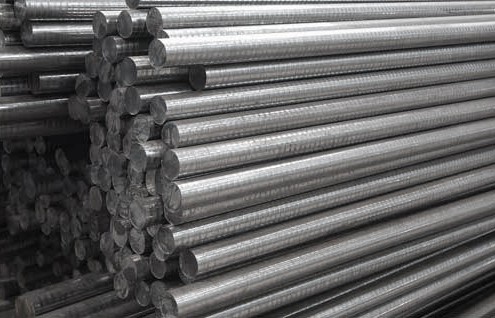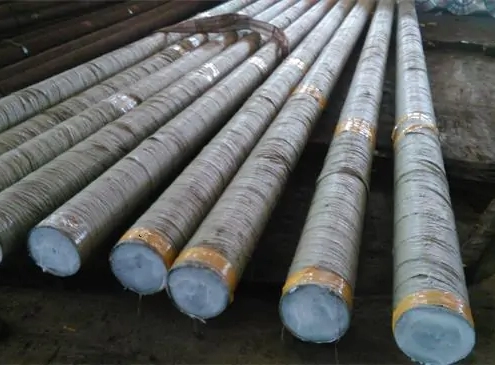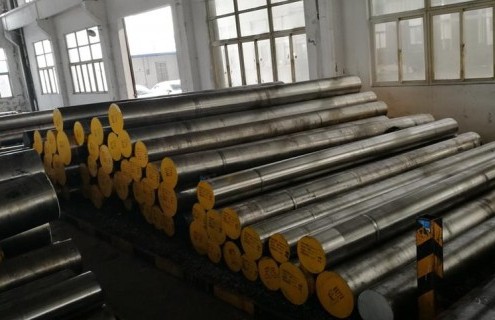EN 41B Nitriding Steel
EN41B Nitriding Steel manufacturers and suppliers,supplied with round rods,square/flat bars,rollers,shafts,blocks and forging pieces.
EN41B is defined as Cr-Mo-Al Nitriding steel as per BS 970 Standard.This material can obtain high wear resistance,good toughness and ductility after nitriding which can give a hard wear resistant case up to 68HRC. After hardened and tempered,EN41B has a tensile strength of 700-850MPa in R condition,and 775-925MPa in S condition. Typical applications for this steel are connecting rods, small extruders, valve stems, injection moulding equipment, hydraulic cylinders, gears, pinions, etc.
EN41B Nitriding Steel Chemical Composition per BS 970 (Nitriding Steel)
| GRADE | C | Si | Mn | P | S | Cr | Mo | Ni | Al |
| EN 41B | 0.35-0.45 | 0.10-0.45 | ≤ 0.65 | ≤ 0.050 | ≤ 0.050 | 1.40-1.80 | 0.10-0.25 | ≤ 0.40 | 0.90-1.30 |
EN41B Nitriding Steel Related Specifications
DIN/EN:41CrAlMo7/34CrAlMo5
W-Nr:1.8509/1.8507
GB:38CrMoAl
ANFOR:40CAD6.12/30CAD6.12
JIS:SACM645
Mechanical Properties
EN 41B exhibits excellent mechanical properties in both untreated and nitrided conditions:
| Property | Normalized | Nitrided |
|---|---|---|
| Tensile Strength | 700–850 MPa | 800–1,000 MPa |
| Yield Strength | 450–550 MPa | 500–700 MPa |
| Elongation at Break | 18–22% | 10–14% |
| Hardness (Core) | 200–240 HB | 230–270 HB |
| Surface Hardness (After Nitriding) | N/A | 850–1,150 HV |
The nitrided surface provides exceptional wear resistance, while the core retains toughness for high-impact applications.
Key Features and Benefits
- High Surface Hardness:
- The nitriding process develops a hard, wear-resistant surface that resists abrasion and fatigue.
- Tough Core:
- Maintains a ductile and impact-resistant core, ideal for dynamic or shock-loading environments.
- Excellent Wear Resistance:
- Enhanced by the nitrided layer, making it suitable for components exposed to high friction.
- Dimensional Stability:
- The nitriding process does not cause significant distortion, ensuring tight dimensional tolerances.
- Corrosion Resistance:
- Improved surface corrosion resistance due to the nitride layer.
Applications of EN 41B Steel
EN 41B is extensively used in industries requiring components with hard surfaces and tough cores:
- Aerospace Industry:
- Piston rods, shafts, and landing gear components.
- Automotive Industry:
- Crankshafts, camshafts, and gears.
- General Engineering:
- Die-cast molds, spindles, and wear-resistant tools.
- Oil and Gas Industry:
- Valve stems, drilling tools, and other high-pressure components.
Heat Treatment of EN 41B Steel
The performance of EN 41B steel can be optimized through various heat treatment processes:
- Normalizing:
- Heating to 850–900°C and air-cooling to refine the grain structure and improve toughness.
- Hardening and Tempering:
- Quenched at 830–870°C in oil, followed by tempering at 540–680°C to achieve a balance of strength and ductility.
- Nitriding:
- Heated to 500–550°C in a controlled nitrogen-rich environment to form a hard surface nitride layer while retaining core properties.
- Stress Relieving:
- Performed at 540–580°C to minimize residual stresses after machining or welding.
Nitriding Process
Nitriding is the defining heat treatment process for EN 41B. The steel is exposed to a nitrogen-rich atmosphere at low temperatures (500–550°C), allowing nitrogen to diffuse into the surface and form a hard nitride layer. The benefits of this process include:
- Exceptional wear resistance.
- Improved fatigue strength.
- Minimal distortion, preserving dimensional accuracy.
- Increased surface corrosion resistance.
Processing Techniques
- Machining:
- EN 41B is machinable in its normalized or annealed state. Carbide tools are recommended for precision machining.
- Welding:
- Preheating to 250–300°C and post-weld stress relieving are essential to avoid cracking.
- Cold Working:
- Limited due to its high strength; suitable for simple forming operations.
- Forging:
- Conducted at 850–1,050°C, followed by slow cooling or normalizing.
Comparisons with Similar Grades
| Steel Grade | EN 41B | EN 40B | AISI 4140 |
|---|---|---|---|
| Nitriding Capability | Excellent | Good | Moderate |
| Surface Hardness | 850–1,150 HV | 700–900 HV | Lower (Post-Nitriding) |
| Core Toughness | High | Moderate | Higher |
| Applications | Wear-resistant parts | Gears, Shafts | General engineering |
Certifications and Standards
EN 41B steel is manufactured to meet international standards:
- BS EN 10085: Case-hardening steels.
- ISO 683-3: Heat-treatable and nitriding steels.
- ASTM A355: Nitriding steels for high-performance applications.
EN 41B Nitriding Steel – The Complete FAQ Guide
EN41B nitriding steel is one of the most common types of steel you use that you don’t recognize. In this guide, we will let be unearthing what EN 41B nitriding steel is, how you can use it to your advantage, and many more!
To help you even further, we will teach you some of the best things for you to land on the best EN41B nitriding steel manufacturer!
What is EN41B Nitriding Steel?
EN41B nitriding steel is a type of steel comprised of main alloying elements, Chromium – Molybdenum – and Aluminum.
Image of what EN41B nitriding steel looks like
It’s distinguished to be a part of the BS 970 standard and is the material you want to use if you’re after good toughness, high wear resistance, and ductility.
Thanks to the nitriding process, all of these properties and traits are improved and developed. EN41B steel is actually one of the most popular and the most used types of free cutting steel that contains low carbon and manganese.
Can You Use EN41B Nitriding Steel Continuously?
Sample of EN41B tools and parts
Yes, as a matter of fact, EN41B steel is most suited and utilized repeatedly, that’s why you will find it most useful to be made and turned into different parts and components like studs, hydraulic fittings, bolts, nuts, dies, pins, and many more!
Understanding What NItriding Steel is
You can easily and simply understand nitriding because it’s one of the heating processes used in steel working.
It’s a procedure that spreads nitrogen onto the metal’s surface so that you get a surface that’s case hardened.
Where Do You Use Nitriding?
More often than not, the process of nitriding is performed on low-alloy, high-carbon types of steels.
Image of a nitriding furnace
However, you can also use it on materials that have medium-to-high carbon levels and content such as molybdenum, aluminum, and titanium.
Where Do You Use EN41B Nitriding Steel?
You will never experience a shortage of where you can use EN41B nitriding steel. As a matter of fact, the following are the most customary applications of it:
- Automotive Sector and Industry
- General Architecture and Engineering
- Textile Industry
- Structural and Construction Industry
NOTE: These aren’t all sectors and industries, there are a lot more than just these. We’ll discuss them later.
Nevertheless, the parts and components where you’ll usually see it include clutch plates, shackle pins, press plates, track pins, valve stems, extruders, dies, and many more!
EN41B Material Properties
By understanding the material or the mechanical properties of EN41B nitriding steel, you will easily be able to assess if it’s something that you need.
Thickness, hardness, and overall machinability – properties of EN41B nitriding steel
With the table below, you will be more aware of the properties and/or the traits of EN41B:
| Condition | Brinell Hardness | Tensile Strength | Yield Strength | Charpy Impact | Elongation |
| R | 201 to 225 Brinell | 695 (minimum) | 525 minimum | 40 J minimum | 40% minimum |
| T | 248 to 302 Brinell | 850 (minimum) | 680 minimum | 35 J minimum | 35% minimum |
| S | 223 to 277 Brinell | 772 (minimum) | 587 minimum | 40 J minimum | 40% minimum |
Should you be unaware if EN41B nitriding steel is what you need, this table of its properties can easily be able to help you!
Equivalent Grades of EN41B Nitriding Steel
If you ever come across the following steel grades, don’t immediately think that they’re 100% identical with EN41B nitriding steel.
They may be tagged as “equivalent” steel grades because of the present elements. However, they’re not 100% identical because the percentage of each element is not the same.
The equivalent grades of EN41B nitriding steel include, but are not limited to:
- BS 970: 1995: EN24T
- BS 970:1991: 817M40T
- SAE or AISI 1040
- 080M40
- 41CrAlMo7
What is the Density of EN41B?
Density of a particular material is calculated and computed via the mass in KG per volume cubic meter.
Steel’s density will vary depending on the alloying elements that are part of it. However, the typical range of steel density lies between 7,750 and 8,050 kg/m3.
Considering all of the alloying elements as well as the content structure of EN41B, its density is 8.08 g/cm3; or about 0.292 lb/in3.
What is the Melting Point of EN41B?
For the benefit of everyone, melting point is the temperature in which a particular material turns from solid to liquid.
Molten EN41B being prepared for machining
In the simplest sense, it’s the temperature needed for an ice cube to become water again.
EN41B, being a steel grade that contains significant amounts of Chromium and Molybdenum, can have a melting point that’s substantially higher than its counterparts.
The melting point of EN41B is at 2,600 degrees Fahrenheit, or about 1,425 degrees Celsius. This is hot enough that it’ll turn the steel into a molten state.
What is EN19 Steel?
EN19 is a type of steel with decent amounts of tensile strength. It’s known to have high quality alloy steel, which paves the way for good levels of shock resistance and overall ductility.
Sample photo of EN19 steel
You will find EN19 steel useful in environments where loading and pressure is present such as the gas and oil industry, the aircraft and automotive industry, the engineering and the machinery manufacturing industry, and many more!
EN40B’s Chemical Composition vs. EN41B’s Chemical Composition
Needless to say, EN40B and EN41B are two (2) steels that are from the same family.
While inexperienced people say that both of these metals have natural links to each other, they’re actually not the same.
In fact, they’re far from what many people expect them to be. To help you with it further, we’ll be giving you tables of each of these steel’s chemical composition.
EN40B’s Chemical Composition
| Carbon | Chromium | Manganese | Molybdenum | Nickel | Phosphorous | Silicon | Sulphur |
| 0.20 to 0.30% | 2.90 to 3.50% | 0.40 to 0.65% | 0.40 to 0.70% | 0.40% (max) | 0.05% (max) | 0.10 to 0.35% | 0.05% (max) |
As you can see, EN40B is dominated by Chromium and Molybdenum, which makes it eligible for better and higher hardenability, all the while improving corrosion and oxidation resistance.
EN41B’s Chemical Composition
Here’s the composition of all the chemicals and the alloying elements of EN41B.
| Aluminum | Carbon | Chromium | Manganese | Molybdenum | Nickel | Phosphorus | Silicon | Sulfur |
| 0.90 to 1.30% | 0.35 to 0.45% | 1.40 to 1.80% | 0.65% (max) | 0.10 to 0.25% | 0.40% (max) | 0.50% (max) | 0.10 to 0.45% | 0.50% (max) |
If we put them side-by-side, we’ll see that the primary difference would be the aluminum content on the EN41B. What this does is it allows the steel to undergo galvanic corrosion, and it’s not the corrosion we know.
You can actually use galvanic corrosion to protect metallic parts and components by forming galvanic cells. This will require sacrificing the metal, and will be under a process called cathodic protection.
EN41B Material Price
How much is EN41B? How much money do you need for it? What is the budget that you need in order to make sure that it is the one you need?
EN41B manufacturing procedure or method
Knowing the rate or the price of EN41B isn’t that easy, in fact, if you search online, you might have an inaccurate calculation of it.
Here’s what you can do to figure out the prices and rates of EN41B:
Search Wholesale Websites
There are tons of wholesale websites you can run to if you’re not sure how much budget you need. There’s Alibaba, WholeSaleCentral, WorldWideBrads, and many more!
You’ll see good rates there, but of course, it’s still going to be better if you choose to work with a direct supplier/manufacturer of EN41B.
Moreover, you can build your relationship to the EN41B nitriding steel manufacturer if you choose to!
Ask Your Manufacturer/Supplier
Should the first option not work for you, and you have a couple of manufacturers on the list, don’t be afraid to ask them. Most EN41B steel manufacturers and suppliers will be capable of giving you a free quotation or a free estimate of whatever your orders are.
In fact, even if it’s your first time talking to that supplier, most of them have quote forms that are for free!
Don’t waste time searching the net to find out how much EN41B nitriding steels are. Even if you get it, you can’t be 100% sure that it’s accurate.
How much you can get it for can be completely inaccurate because the price of retail products and wholesale products are different, the prices of suppliers from different countries will definitely be different, and the like.
Is 41CrAlMo7 and EN41B NItriding Steel the Same?
One of the equivalent metals and materials that EN41B has is 41CrAlMo7. However, they’re not 100% the same, akin to other equivalents of EN41B nitriding steel.
However, they’re the same when it comes to the alloying elements that are contained and used to create the steel.
So, the next time you encounter 41CrAlMo7, don’t confuse it with EN41B. They are the same, but since they’re part of different standards, they can’t be 100% the same altogether.
Which Industries Utilize EN41B Nitriding Steel the Most?
While there’s a multitude of sectors and industries, there are some industries and business sectors that find it useful in some of their parts and their components as well.
EN41B steel is utilized in a wide array of sectors and industries
These include, but are not limited to:
- Marine and Maritime Applications
- Railroad and Transport Applications
- Aviation, Space, and Defense (ASD) Applications
- And Many More!
What is the Heat Treatment Process of EN41B?
For the benefit of everyone, heat treatment is the process of altering or modifying the structure of a material by subjecting it to extremely high and fluctuating temperatures.
Unlike most steels, EN41B is heat treated at about 870 to 930 degrees Celsius. The procedure should be done slowly and constructively in order for it to successfully be treated and hardened.
What is the Hardness of EN41B Nitriding Steel?
Similar to different types and kinds of steels, EN41B nitriding steel would have different hardness levels depending on the heat treatment done to it.
For instance, if it’s annealed at temperatures ranging between 840 and 870 degrees Celsius, the hardness level that it can reach could be up to a maximum of 229 HB. After nitriding, it can reach a harness level of 1,000 to 1,100 HV.
Therefore, you really wouldn’t have any values on how the hardness of EN41B is. You can actually choose what type of procedure you can have it undergo.
The Best Place to Get EN41B Nitriding Steel
In case you’re wondering where you can get high quality EN41B nitriding steel, you can never go wrong in choosing us here at Waldun Steel.
For many years, we’ve been providing all our clients with the EN41B nitriding steel that they need for their business. Whether they need it in round bars, in steel plates, sheets, squares, and even custom shapes and forms, we here at Waldun Steel will be able to help you!
Other than EN41B nitriding steel, we can also help you if you need other types of metals such as P20+S steel, H13 steel, T5 Steel, 1020 steel, and many more!
Why Choose Us Here at Waldun Steel?
Our business knows no complaints, we will provide all of the highest possible quality of steel you need for your business.
We perform all different types and kinds of testing including, but not limited to:
- Third Party Testing
- Hardness and Metallurgical Testing
- Mechanical Testing
- Ultrasonic Testing
- Chemical Composition Control and Testing
- Sample Analysis
- And Many More!
Should you want to check out our factory or our manufacturing plant, you can do so! All our people and our experts here at Waldun Steel will never leave you out alone!
Reach out to us by dialing our hotline or by shooting us an email – we’ll be more than happy to help!
Talk to us wherever you might be – we’re just a call or an email away!
Other Related Steel
Page Contents
- EN41B Nitriding Steel Chemical Composition per BS 970 (Nitriding Steel)
- EN41B Nitriding Steel Related Specifications
- Mechanical Properties
- Key Features and Benefits
- Applications of EN 41B Steel
- Heat Treatment of EN 41B Steel
- Nitriding Process
- Processing Techniques
- Comparisons with Similar Grades
- Certifications and Standards
- EN 41B Nitriding Steel – The Complete FAQ Guide
- What is EN41B Nitriding Steel?
- Understanding What NItriding Steel is
- Where Do You Use Nitriding?
- Where Do You Use EN41B Nitriding Steel?
- Equivalent Grades of EN41B Nitriding Steel
- What is the Density of EN41B?
- What is the Melting Point of EN41B?
- What is EN19 Steel?
- EN40B’s Chemical Composition vs. EN41B’s Chemical Composition
- EN41B Material Price
- Is 41CrAlMo7 and EN41B NItriding Steel the Same?
- Which Industries Utilize EN41B Nitriding Steel the Most?
- What is the Heat Treatment Process of EN41B?
- What is the Hardness of EN41B Nitriding Steel?
- The Best Place to Get EN41B Nitriding Steel
- Why Choose Us Here at Waldun Steel?
- Other Related Steel



















